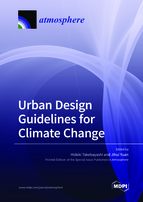Urban Design Guidelines for Climate Change
A special issue of Atmosphere (ISSN 2073-4433). This special issue belongs to the section "Climatology".
Deadline for manuscript submissions: closed (31 March 2021) | Viewed by 43202
Special Issue Editors
Interests: urban heat islands; mitigation and adaptation measures; cool roof; green roof; cool pavement; urban ventilation; radiant environment; air conditioning load
Special Issues, Collections and Topics in MDPI journals
2. Department of Architecture and Civil Eng., Graduate School of Eng., Toyohashi University of Technology, 1-1 Hibarigaoka, Tempaku-cho, Toyohashi, Aichi 441-8580, Japan
Interests: building thermal environment; retro-reflective materials applied to building facades; weather data for building energy savings; urban heat island mitigation
Special Issues, Collections and Topics in MDPI journals
Special Issue Information
Dear colleagues,
The journal Atmosphere is launching a Special Issue on the research topic of “Urban Design Guidelines for Climate Change” and is inviting researchers from all world-leading Universities and Research Institutions to contribute their research achievements in this field.
The Special Issue aims to publish state-of-art research findings or review articles addressing the problems and future challenges in improving (1) urban and architectural designs that mainly includes reasonable and effective application of new advanced materials and renewable energy in urban buildings; (2) urban landscapes that mainly include layout of urban blocks and urban greening coverage; and (3) other research fields related to urban environmental engineering to cope with the current climate change phenomenon and reduce environmental burden.
The Special Issue covers the following topics:
- Evaluation of the interaction between urban building and urban climate by means of field measurement, experimental models, and numerical simulation;
- Impact of urban landscape change on urban climate or local microclimate environment;
- Application of new advanced building materials for urban heat island mitigation and energy savings;
- Selection of climatic conditions for building design;
- Building load simulation and calculation.
Prof. Dr. Hideki Takebayashi
Prof. Dr. Jihui Yuan
Guest Editors
Manuscript Submission Information
Manuscripts should be submitted online at www.mdpi.com by registering and logging in to this website. Once you are registered, click here to go to the submission form. Manuscripts can be submitted until the deadline. All submissions that pass pre-check are peer-reviewed. Accepted papers will be published continuously in the journal (as soon as accepted) and will be listed together on the special issue website. Research articles, review articles as well as short communications are invited. For planned papers, a title and short abstract (about 100 words) can be sent to the Editorial Office for announcement on this website.
Submitted manuscripts should not have been published previously, nor be under consideration for publication elsewhere (except conference proceedings papers). All manuscripts are thoroughly refereed through a single-blind peer-review process. A guide for authors and other relevant information for submission of manuscripts is available on the Instructions for Authors page. Atmosphere is an international peer-reviewed open access monthly journal published by MDPI.
Please visit the Instructions for Authors page before submitting a manuscript. The Article Processing Charge (APC) for publication in this open access journal is 2400 CHF (Swiss Francs). Submitted papers should be well formatted and use good English. Authors may use MDPI's English editing service prior to publication or during author revisions.
Keywords
- climate change
- urban and architectural design
- advanced building materials
- urban landscape
- renewable energy
- energy saving







